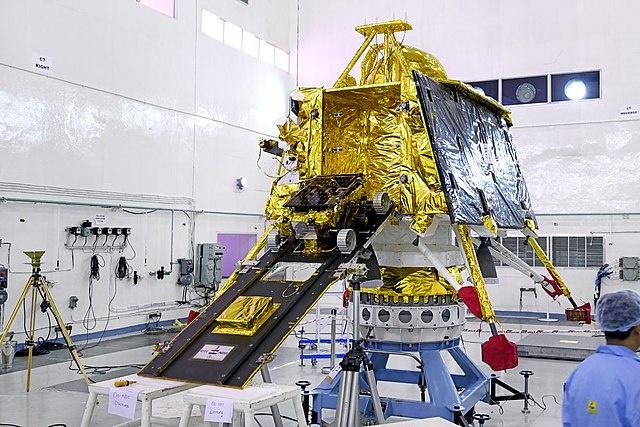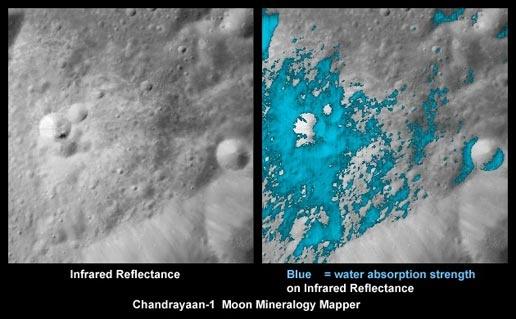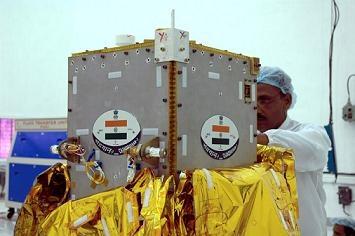
Rover Pragyan mounted on the ramp of Vikram lander.
The mission's lander is called Vikram named after cosmic ray scientist Vikram Sarabhai (1919–1971), who is widely regarded as the founder of the Indian space programme. The Vikram lander detached from the orbiter and descended to a low lunar orbit of 30 km × 100 km (19 mi × 62 mi) using its 800 N (180 lbf) liquid main engines. After checking all of its on-board systems it attempted a soft landing that would have deployed the rover, and performed scientific activities for approximately 14 Earth days. Vikram crash-landed during this attempt. The combined mass of the lander and rover was approximately 1,471 kg (3,243 lb).
The preliminary configuration study of the lander was completed in 2013 by the Space Applications Centre (SAC) in Ahmedabad. The lander's propulsion system consisted of eight 58 N (13 lbf) thrusters for attitude control[60] and five 800 N (180 lbf) liquid main engines derived from ISRO's 440 N (99 lbf) liquid apogee motor.[61][62] Initially, the lander design employed four main throttle-able liquid engines, but a centrally mounted fixed-thrust engine was added to handle new requirements of having to orbit the Moon before landing. The additional engine was expected to mitigate upward draft of lunar dust during the soft landing. Vikram was designed to safely land on slopes up to 12°.
Some associated technologies include:
- A high resolution camera, Laser Altimeter (LASA)
- Lander Hazard Detection Avoidance Camera (LHDAC)
- Lander Position Detection Camera (LPDC)
- Lander Horizontal Velocity Camera (LHVC), an 800 N throttleable liquid main engine
- Attitude thrusters
- Ka-band radio altimeters
- Laser Inertial Reference and Accelerometer Package (LIRAP) [70] and the software needed to run these components.
Engineering models of the lander began undergoing ground and aerial tests in late October 2016, in Challakere in the Chitradurga district of Karnataka. ISRO created roughly 10 craters on the surface to help assess the ability of the lander's sensors to select a landing site.
- Dimensions: 2.54 m × 2 m × 1.2 m (8 ft 4 in × 6 ft 7 in × 3 ft 11 in)
- Gross lift-off mass: 1,471 kg (3,243 lb)
- Propellant mass: 845 kg (1,863 lb)
- Dry mass: 626 kg (1,380 lb)
- Power generation capability: 650 watts
- Mission duration: ≤14 days (one lunar day)
Source: https://en.wikipedia.org/wiki/Chandrayaan-2#Vikram_lander_2


